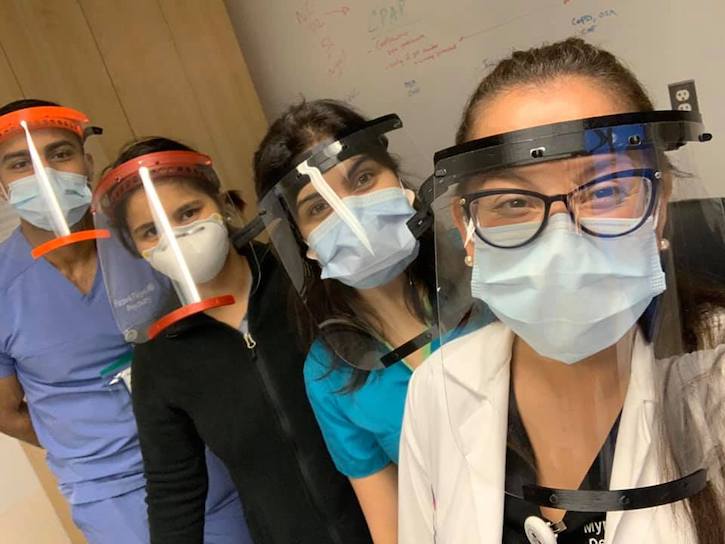
In response to COVID-19, a group of George Mason University students had planned to create 3D printed personal protective equipment (PPE), such as face shields and masks for health care professionals and their patients. When the announcement came on March 22 that Mason campuses were closing, they knew they had to move fast.
“We moved our equipment [from the MIX] off campus,” said Amanda Jarvis, MIX innovations program manager who is coordinating the team’s effort.

Senior Denys Kuratchenko said he retrieved his personal 3D printer from the space, and received permission from Jarvis to take another three from the MIX. He’s now running a 24/7 “print farm” from his apartment in Triangle, Virginia, he said, and has ordered a fifth printer to increase production capacity.
It takes about four hours to print each frame for the face shield, Kuratchenko said, and, so far, he has made more than 65 that were part of a shipment delivered to Elmhurst Hospital in Queens, New York.
“I’m not only helping other doctors, but also keeping their loved ones safe, and [giving them peace of mind in] knowing that their loved ones who are doctors are more protected,” said Kuratchenko, an information systems and operations management major.
After the face shield frames are printed, Kuratchenko sends them to Eric Bubar, associate professor of physics at Marymount University, who matches the 3D-printed parts with laser-cut shields and makes the deliveries to health care providers who have indicated a need.

“I applaud the collaborative efforts of our team who have come together to protect medical professionals on the front lines,” said Karen Livingston, associate director for entrepreneurship programs, who leads the MIX. “We are fortunate to have such outstanding students and partners joining together to make a difference.”
The Mason student’s efforts are part of a larger movement in the Northern Virginia maker community to address the shortage of PPE during the pandemic, Bubar said. Mason, Northern Virginia Community College, Marymount, Arlington Public Schools, and eNABLE DC are all part of the network.
“None of this would be possible without GMU’s excellent contributions to the efforts and their collaborative spirit,” Bubar said. “To quote the doctor who received them, ‘these are like gold.’”

In addition to student efforts, Livingston and Jarvis said they are working to lead administrators and professors across campus around 3D-printing efforts and ventilator prototyping in response to COVID-19.
With the supply of disposable face masks declining, patients are also in need, and the Mason team has mobilized here as well.
This week, Jarvis is sourcing materials to distribute to makers in the MIX community who will be sewing masks to fulfill incoming requests, including for a local cancer ward.
It takes about 15 to 20 minutes to sew a fabric mask, and Jarvis said she is experimenting in her home studio with how to streamline the process, possibly through laser cutting the fabric.
“It’s a good use of the MIX team skills,” said Jarvis, “It’s our time to respond.”
Bradford Webb, a computer engineering senior, isn’t printing or sewing, but is still vital to operation.
He ensures the products the Mason team creates are the best and most usable they can be. He said he spends his time outside of class evaluating open source PPE prototypes, looking at research on which materials work best, and seeing which ones will be accepted at different medical locations.

“It’s very helpful in making sure the prototypes we’re developing are effective for local health care providers, especially because the info we’re getting changes as the understanding of the virus improves,” Webb said.

Staying home has been a challenge, the team agreed, but the project gives them purpose.
“To feel like I can contribute and help out, and also seeing the rest of the maker community responding this way, gives me a lot of hope for the future,” Jarvis said.
In addition to helping flatten the curve by getting PPE to the right people at the right time, their effort shows what’s possible, Webb said.
“You don’t necessarily have to be part of a very large group to help out in times of need,” Webb said. “Collaborate with the right people and it’s possible to make it work.”
